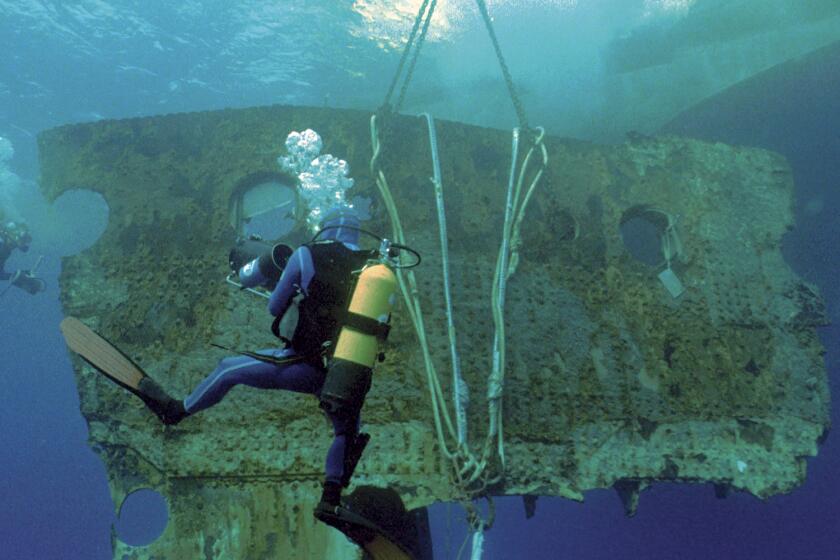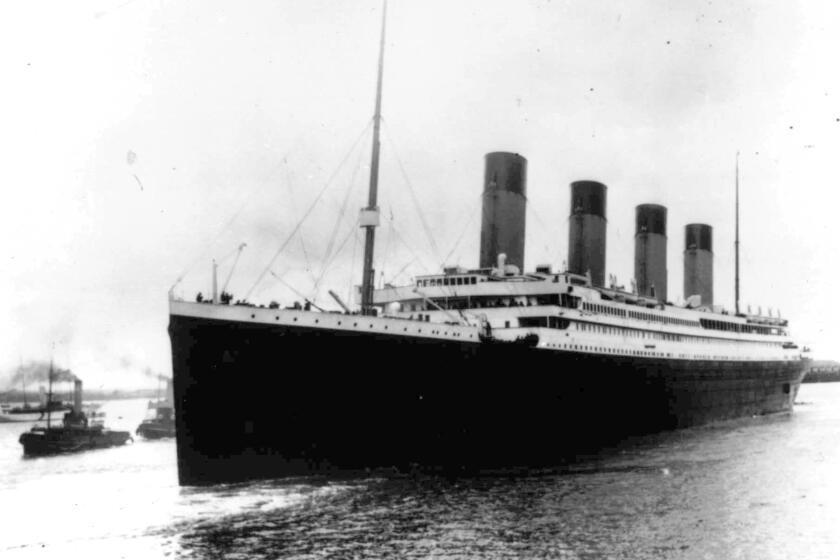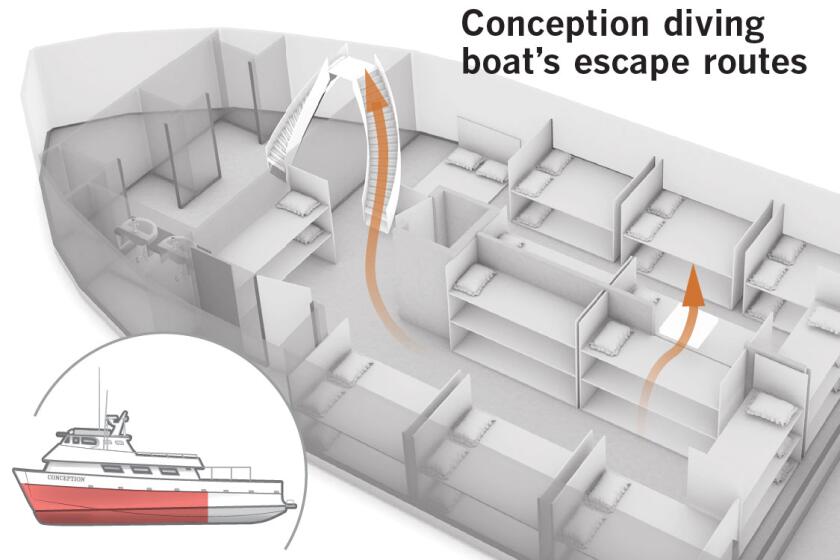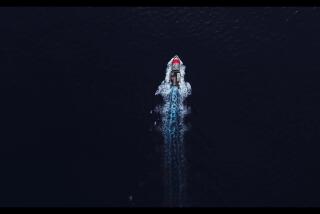‘Banging’ heard, raising hopes that passengers of vanished Titanic tourist sub are still alive
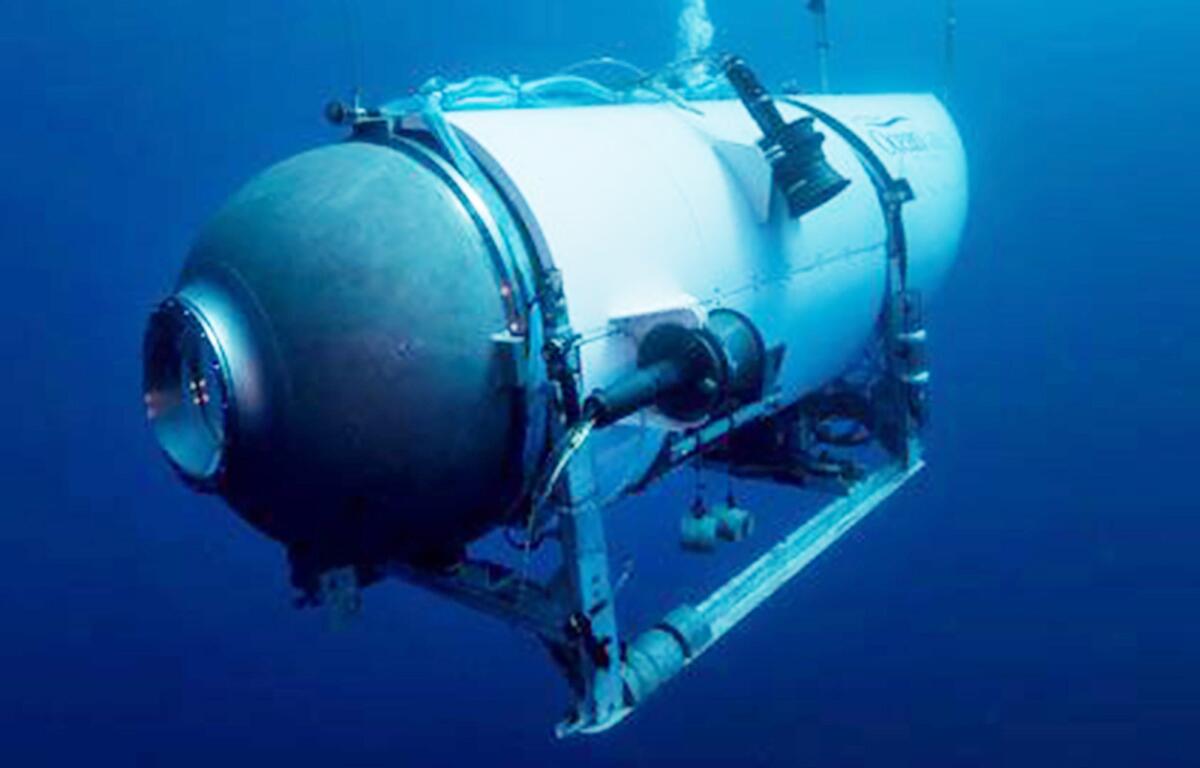
- Share via
As search-and-rescue teams raced against the clock Tuesday to find a submersible that vanished on an expedition to explore the wreck of the Titanic, a group associated with two of the people believed to be on board issued a statement saying there was “cause for hope” that the passengers were alive.
“There is cause for hope, based on data from the field — we understand that likely signs of life have been detected at the site,” the statement read.
The statement followed a report by Rolling Stone that “banging” had been detected at 30-minute intervals within the area where the submarine disappeared. The report was based on internal emails from the U.S. Department of Homeland Security’s National Operations Center that said a Canadian aircraft had detected the noise after deploying several “sonobuoys.”
The mission, in a remote area of the Atlantic, is a complex search effort requiring expertise and equipment that involves multiple agencies from the U.S. and Canada, along with OceanGate Expeditions, which owns and operates the missing sub, Capt. Jamie Frederick, a response coordinator with the U.S. Coast Guard’s 1st District, said at a news conference Tuesday.
Officials said the effort covers an area of about 7,600 square miles — larger than Connecticut — focusing both on surface and subsurface search.
“Those search efforts have not yielded any results,” Frederick said.
As of Tuesday afternoon, officials believed there were about 40 hours of emergency oxygen left in the submersible, named the Titan, based on the initial air supply of 96 hours.
A search-and-rescue mission is underway after a submersible used for tourist expeditions to view the Titanic wreck went missing Sunday with five aboard.
OceanGate said its chief executive, Stockton Rush, is one of the five people aboard the missing 21-foot sub. He’s the pilot of the vessel carrying four other people.
Though officials have so far declined to release any details of those aboard, the other four people have been identified through public statements. They include Hamish Harding, chairman of Action Aviation, a Dubai-based company dealing in aviation sales and acquisitions, and Paul-Henry Nargeolet, a veteran and accomplished diver with more than 30 trips to the wreck site. Harding and Nargeolet are both members of the Explorers Club, according to the professional society. Also on board are Pakistani businessman Shahzada Dawood and son Sulaiman.
Since Sunday evening, C-130 aircraft have been conducting surface searches, including with radar, and P-3 aircraft have dropped sonar buoys for subsurface detection. An underwater robot with specialized equipment has been deployed, Frederick said. A Canadian P-3 aircraft is conducting a six-hour search of the area, with more expected Tuesday evening.
- Share via
A search-and-rescue mission is underway after a submersible used for tourist expeditions to view the Titanic wreck went missing in the North Atlantic.
Additional Canadian coast guard vessels also are expected to arrive, along with divers from the U.S. Navy. More private research vessels are making preparations to join the efforts, and several civilian ships also have volunteered to help, Frederick said.
Experts have said the mission is complex because of its remote location, which means it takes longer to deploy equipment, and because it covers areas above and below the surface of the Atlantic. Frederick described the effort to deploy equipment to the scene as a “full-court press.”
But even if the vessel is located, the rescue could be equally complicated, particularly given the dwindling oxygen supply. “We will do everything in our power to effect a rescue,” Frederick said.
Former U.S. Coast Guard Capt. Andrew Norris said that it’s “extraordinarily unlikely” that the five people on the submersible can be saved at this point, emphasizing the logistical challenges. “It’s really a very novel, very, very, very challenging situation,” he said.
Norris said the main hope is that the submersible has resurfaced and could be found on the water, and officials have not ruled out that possibility. But Norris said that if it is entangled in the wreck’s debris thousands of feet below the surface, for example, extrication would be very difficult, given the time constraints.
The sub lost contact with the Canadian research vessel Polar Prince about 1 hour and 45 minutes into its dive Sunday morning, about 900 miles east of Cape Cod, Mass., the U.S. Coast Guard said.
The search is unfolding in a far-flung location about 13,000 feet deep, officials have said.
OceanGate organized the dive and owns and operates the missing submersible. The company has been running expeditions with “citizen explorers” to the Titanic since 2021 on its Titan sub, according to its website. The trip can cost around $250,000.
According to its website, OceanGate is a privately owned company in Everett, Wash., established in 2009, that operates a trio of five‑person submersibles for “site survey, scientific research, film production and exploration travel.” Its vessels can reach depths of about 13,123 feet, the company said.
The company offers an eight-day, seven-night voyage to the Titanic wreck, according to its website. The round-trip from St. John’s in Canada takes “intrepid travelers” to explore the Titanic wreck. Dives can begin as early as Day 3.
It could be the blockbuster film, the human angle or technology’s limits. Nowhere does it resonate more than in Halifax, Canada, where some of the victims are buried.
Harding had detailed parts of his trip that began Friday across social media until he went missing Sunday. A “weather window” had opened up, allowing for a dive to the wreck Sunday, Harding wrote on his Facebook page. It was likely to be the only “manned mission” this year because of the harsh winter, he wrote.
His company, Action Aviation, also posted on Twitter about the voyage.
Last summer, CBS news correspondent David Pogue went aboard the Titan for an expedition to the Titanic wreck and interviewed Rush.
Pogue described the Titan as having as “much room as a minivan” and containing “improvised” pieces of equipment, which included a ceiling fixture that Rush said was acquired from Camping World and a video game remote control that Rush said runs “the whole thing.” A waiver for the Titan declared the “experimental” vessel is not “approved or certified by any regulatory body” and could result in physical injury, disability, emotional trauma or death.
Bestselling novelist Lisa See brings’The Island of Sea Women’ to the L.A. Times Book Club
The first attempt by Pogue’s expedition to reach the wreck resulted in the sub getting lost for a few hours because of a communication breakdown with the surface vessel, which sends text messages to guide the sub’s journey because there is no GPS underwater. The team’s second attempt to locate the Titanic was successful.
OceanGate has faced criticism previously.
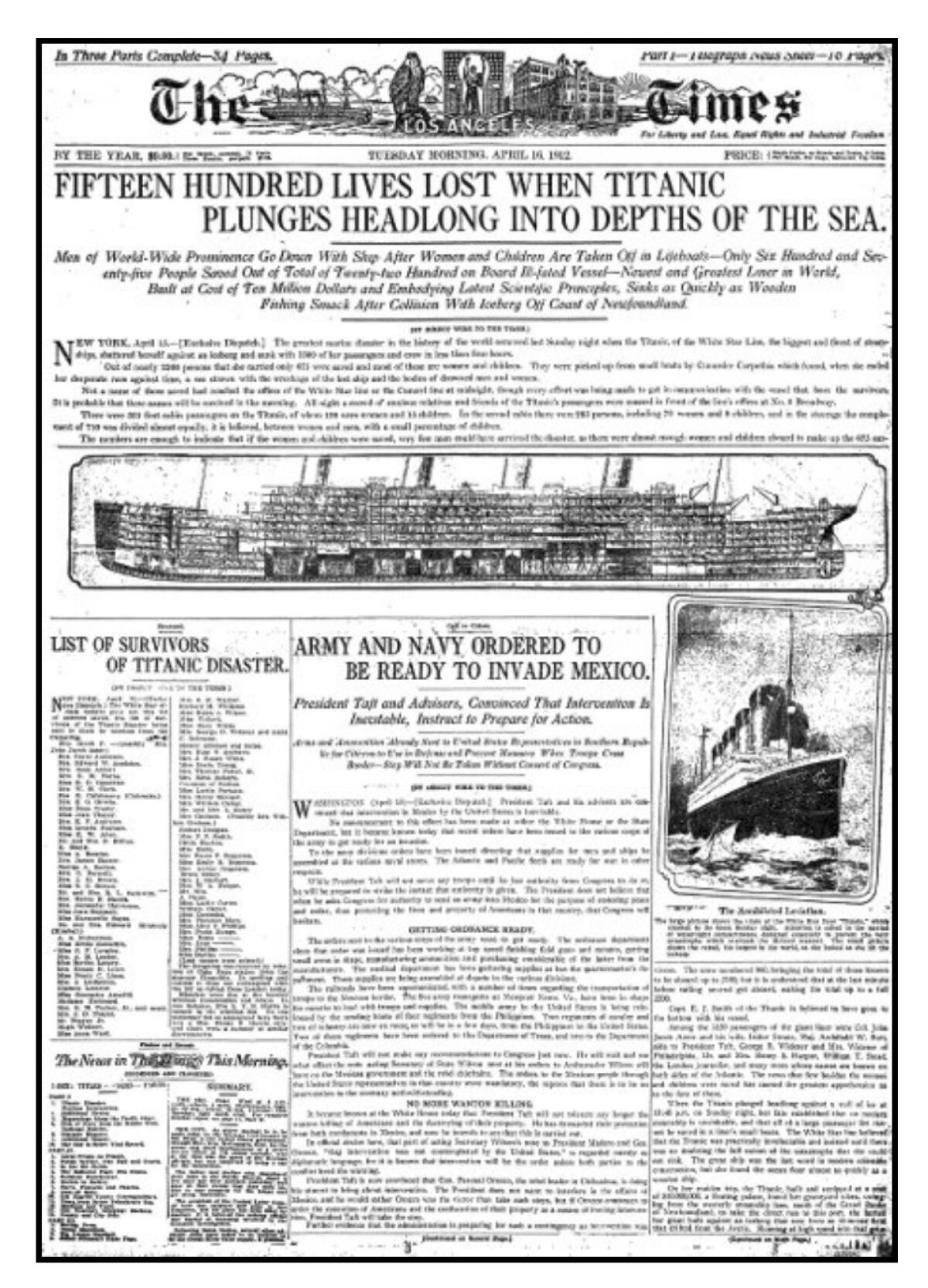
Rush’s peers in the submersible industry expressed deep concern about the Titan and what they described as OceanGate’s refusal to adhere to certain industry safeguards. In a private letter to Rush in March 2018, the Manned Underwater Vehicles Committee at the Marine Technology Society called on him to allow for third-party safety review of OceanGate’s submersibles.
“Our apprehension is that the current experimental approach adopted by OceanGate could result in negative outcomes (from minor to catastrophic) that would have serious consequences for everyone in the industry,” the letter stated.
William Kohnen, the chairman of the committee, told The Times that Rush’s more cavalier style of innovation troubled industry leaders, who felt compelled to speak out. “OceanGate raised a number of eyebrows and was the subject of many conversations,” Kohnen said.
That same year, David Lochridge, a former OceanGate employee, raised red flags about the Titan in litigation against the company, “particularly OceanGate’s refusal to conduct critical, non-destructive testing of the experimental design of the hull.” Lochridge, a submersible pilot hired to do quality and safety inspections, said he was terminated for coming forward. He said he disagreed with Rush’s decision to “subject passengers to potential extreme danger in an experimental submersible.”
Federal investigators recover a video recorded by a victim of the Conception boat fire tragedy as the 34 people trapped below deck tried to escape.
OceanGate said in its own court papers that Lochridge did not accept information provided by a lead engineer on the vessel’s safety. It also claimed that he filed a false report with the Occupational Safety and Health Administration and that he violated his contract by discussing the company’s confidential information with outside parties.
The case was settled in 2018. Lochridge did not immediately respond to a request for comment.
In a 2022 article in Maptia, a digital storytelling platform, Rush took shots at the submersible industry.
“One of the jabs that gets thrown at us is: ‘Hey, you aren’t certified.’ But how can you do something new and get certified?” Rush asked. “If the rules exist for how to do it, then you are operating outside of the rules by doing something different. I think it was MacArthur who said, ‘You are remembered for the rules you break.’ We try to break the rules intelligently and intentionally.”
The Titanic was a British luxury liner that embarked on its maiden voyage from Southampton, England, on April 10, 1912, bound for New York with 2,227 passengers and crew aboard. But the vessel, then the largest in the world, hit an iceberg and sank in the early hours of April 15, killing more than 1,500 people. In September 1985, an American and French team of researchers found the liner thousands of feet below the surface of the ocean.
Times staff writers Summer Lin and Jeremy Childs contributed to this report.
More to Read
Sign up for Essential California
The most important California stories and recommendations in your inbox every morning.
You may occasionally receive promotional content from the Los Angeles Times.
